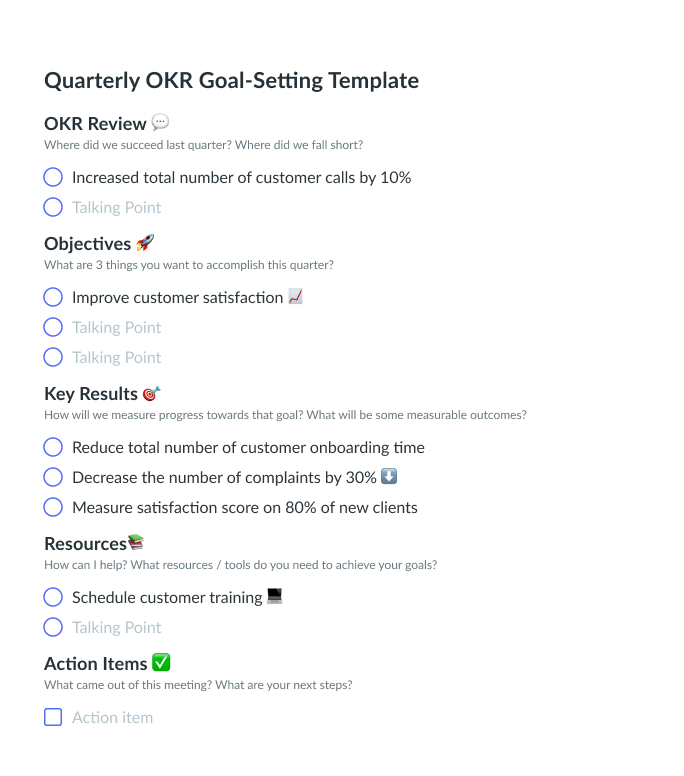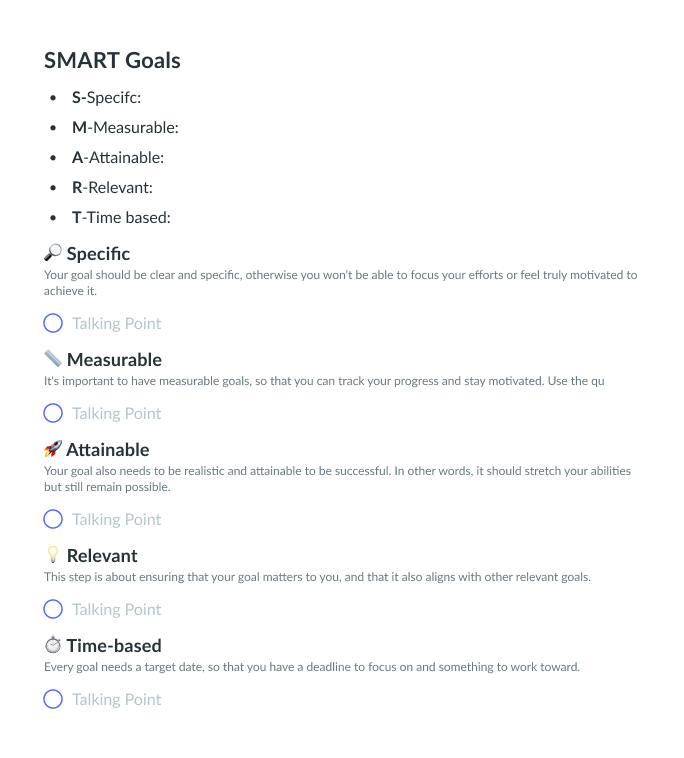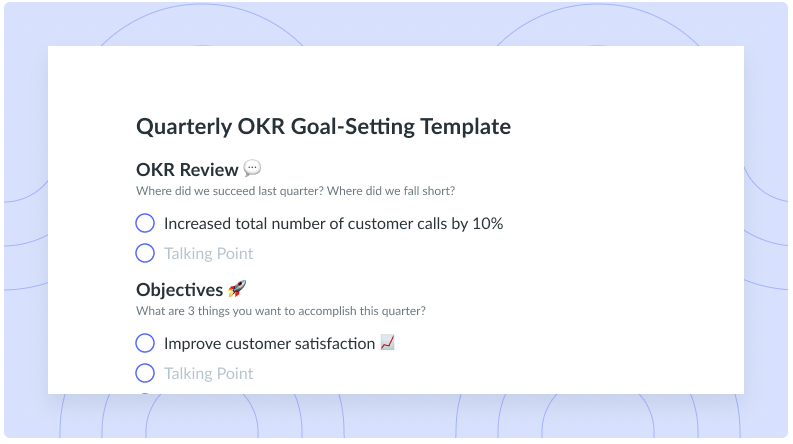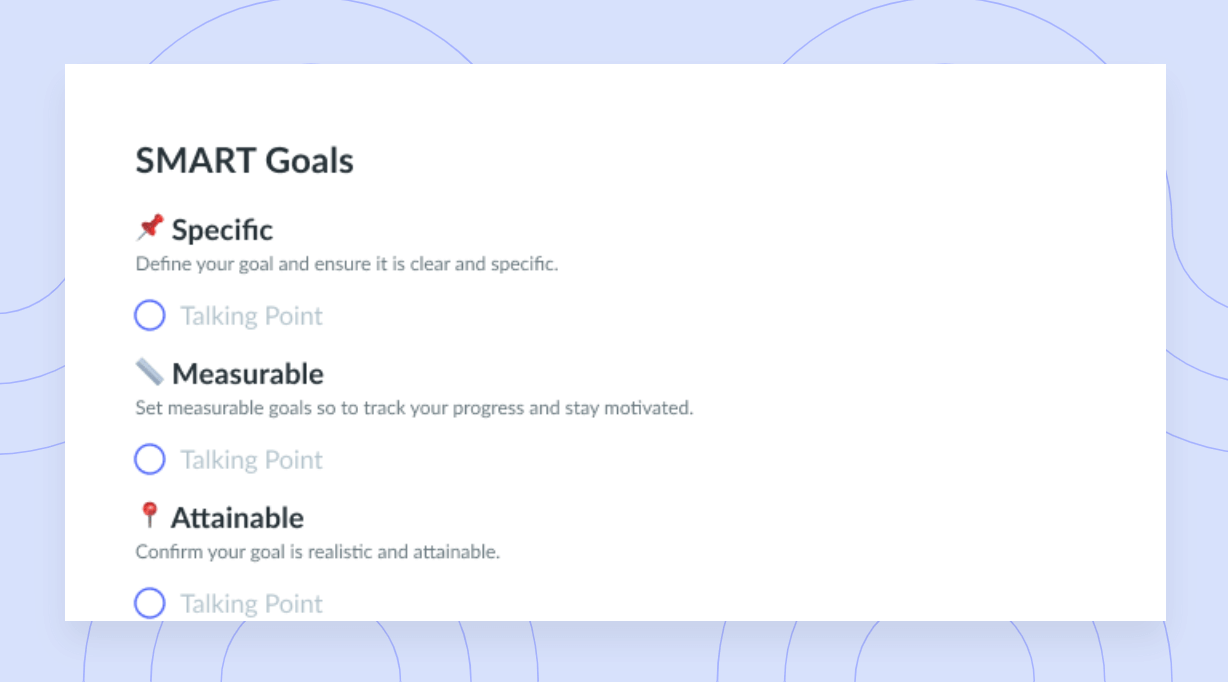OKR vs. SMART Goals: What’s the Difference and When to Use Either
OKR and SMART Goals are both methods that can help you design and set goals for your team to work toward -- but what’s the difference between these two methods?
Setting goals can sometimes seem like pulling ideas out of thin air and attaching deadlines to them. But goals don’t – and shouldn’t — have to be this way. When set and implemented effectively, goals can help align your team’s efforts and launch your organization to new levels. And that’s proven: An Elsevier study found that effectively setting goals can improve team performance by 15 percent.
OKRs and SMART goals are two goal-setting concepts that can help you guide your team to productive workdays, fulfilling projects, and schedules that use their time wisely. But how you get there is a different question to ask. When assessing OKRs vs. SMART goals, you’ll want to consider which is the better approach for your organization. If you’re ready to learn more, this article has all the information you need to get you and your team on your way to goal-setting success.
- What are OKRs?
- How do OKRs work?
- What are SMART goals?
- How do SMART goals work?
- What do OKRs and SMART goals have in common?
- The differences between OKR and SMART goals
- When to use OKRs vs SMART goals
- OKR template
- SMART goals template
What are OKRs?
Objectives and key results (OKRs) are metrics that managers and team members use to set organizational goals. These measurements outline your desired results and how you expect to achieve them. With the OKR methodology, objectives are the “what” of the framework. They state exactly what you want your team to accomplish. Key results are the “how.” They lay out the paths your team members will take to complete each objective and accomplish the greater goals.
OKRs can help your team grow in ways that may have once seemed entirely too difficult. They can help your team efficiently expand their capabilities while also enhancing their performance. OKRs assess clearly defined objectives and the results you expect to achieve from each of them. You can use OKRs for your entire company, specific teams, or even individuals. Regardless of how you choose to implement this methodology, OKRs work best when they’re narrowly focused to accomplish specific, ambitious goals.
For example, a company manager might create an OKR to increase their company’s website traffic by 20 percent. The key results for this objective could be to increase the company’s email open rate by 15 percent or mail at least 200 flyers for an online promotion. With this strategy, the employees have a clear goal (increase website traffic) with defined steps to help them get there (improve their email open rate and mail 200 flyers).

Stay on top of your goals.
Accomplish your goals and keep track of next steps all in one place with a tool like Fellow.

How do OKRs work?
OKRs can bring structure and points of measurement into your team’s daily workflow. They give you and your employees a clear guide on how to accomplish a goal, and you can create specific tasks necessary to achieve each key result. To accomplish this, your objectives and key results need to have a few factors to truly be done right.
Actionable objectives can encourage your team members to assume individual roles in working toward an overall goal. Creating objectives that are specific to your company’s needs and adjusting them to your team’s capabilities can help you produce the best results for your team and company.
With key results, the criteria you choose to create them should be measurable and realistic. You should have a way to track progress on each result, and your team should be able to achieve the results within a reasonable time frame. This way, you can set a feasible timeline for progress and measure the success of your team’s work.
To implement OKRs into your team’s workflow, you’ll need to first teach your team members the basics of the OKR methodology. You should also communicate your expectations for their work, along with the timeline in which they need to complete the objective. As your employees work toward the objective, monitor their progress according to the key results you defined. You should also give your team members feedback and constructively assess their work.

What are SMART goals?
S.M.A.R.T. is an acronym of criteria (Smart, Measurable, Achievable, Relevant, Time-bound) for setting attainable goals. These goals are objectives that are actionable and help you and your team decide exactly what you want to accomplish and figure out the resources needed to meet that target.
George T. Doran became the first known person to use SMART goals way back in 1981. Doran was a former director of Corporate Planning for Washington Water Power Company. He believed executives often set goals that were either too broad or difficult for their direct reports to understand. He believed this problem could lower the quality of a team’s work or make their efforts entirely ineffective.
In an issue of “Management Review,” Doran published an article that presented the key principles of these goals. “There’s a S.M.A.R.T. way to write management’s goals and objectives,” he wrote. Companies across all industries have since used SMART goals as a framework to simply, yet effective, set goals for their teams.
How do SMART goals work?
Fortunately, the guidelines for how to create SMART goals lie in the name. Each letter in the acronym gives guidelines for how you can structure your goals to guide your team toward success. SMART goals are:
- Specific. The goal is clearly defined and explains exactly what your team needs to achieve. For example: Increase the number of views for the company’s web series. This goal gives employees a clear sight of where they should focus their efforts.
- Measurable. There is a metric attached to the goal so team members have an idea of how far they have come and how much further they need to go. For example: Have at least 1,000 views for each episode of the company web series. This goal sets “1,000” as the target number, so employees know the goal isn’t completed until each episode receives at least 1,000 views.
- Achievable. While the goal doesn’t necessarily have to be easy, it should be within your team’s capability. Having unrealistic goals can negatively affect employee productivity, performance, and morale. For this reason, the goal should be realistically attainable to encourage both efficiency and growth. In the previous examples, if the online episodes currently average 25 views each, setting the goal to 1,000 views per episode could seem overly ambitious. Instead, consider adjusting the goal to receive 100 views for each episode.
- Relevant. The goal should ultimately contribute to improving a company, employees, or clients. If the goal doesn’t pertain to the company’s overall success, it could be unnecessary and keep a team from accomplishing more important tasks. For example: Have at least 100 views for each episode in the company’s web series to inform potential clients of our services and expertise. With this approach, the goal is furthering other goals within the company.
- Time-bound. The goal should have a specific time frame in which a team needs to complete it. Having a target date lets the team know when it needs to achieve the desired results so everyone can plan their work accordingly. For example: By April, have at least 100 views for each episode in the company’s web series to inform potential clients of our services and expertise.
What do OKRs and SMART goals have in common?
A study by IZA World of Labor reported having goals can increase employees’ output by 15 percent. The publication also stated the goal-setting techniques can boost motivation and performance among team members. By using OKRs and SMART goals, you’re acknowledging the fundamental role goals hold in organizing and launching productive efforts. To further examine these goal-setting frameworks, below are some similarities that exist between these two methods.
1 Origin
Both the OKR methodology and SMART goals originated with Peter Drucker’s theory of Management by Objectives (MBO). Drucker, a management consultant and educator, explained this theory in his 1954 book, “The Practice of Management.” In this publication, the author presented ways for managers to effectively convey objectives to their team members. Today, OKRs and SMART goals developed from MBO and aim to help an organization’s members reach success.
2 Specificity
OKRs and SMART goals require an element of specificity for defining their objectives. By making your goal as specific as possible, you’re helping your team members narrow their focus and direct their efforts in one direction.
3 Measurement
Both SMART goals and the key results of OKRs are measurable. Ideally, they’re based on a numerical value so you can track your team’s progress in comparison to the target.
4 Clarity
The primary purpose of OKRs and SMART goals is to help your team clearly understand the goals you’re presenting. For this reason, both concepts produce direct and simple outputs to minimize confusion among team members and increase productivity.
The differences between OKR and SMART goals
At a glance, OKRs and SMART goals can seem very similar. You might be wondering what separates these concepts from each other. Think of the concepts this way: SMART goals often take a simpler approach than OKRs and can even be a way to set key results for the latter methodology. To help separate the two concepts, here are some key differences between OKR and SMART goals.
- Methodology vs. criteria
- Stretch vs. attainable goals
- Long-term vs. short-term
- Multiple metrics vs. one metric
1 Methodology vs. criteria
Perhaps the greatest difference between OKRs and SMART goals is in structure. OKR is a methodology, a sort of stepping-stone sequence, to help your team get from point A to point B. OKR requires you to assess your team’s progress toward each key result and set new key results within the objective to encourage consistent momentum. It’s an entire process.
The SMART acronym, on the other hand, is less of a process and more of a list of guidelines for setting goals. SMART presents criteria to help you set smaller, individual goals. While these goals can span multiple teams or departments, SMART aims to focus efforts in a specific area instead of on a larger objective.
2 Stretch vs. attainable goals
OKRs are designed to inspire growth among your team members and advance their potential. To achieve this result, OKRs need to be ambitious and aggressive. Also known as stretch goals, these ambitious targets should challenge your team’s capability. While they shouldn’t be impossible, OKRs should push your team’s efforts (and achievements) beyond what you once thought was possible. Because of their difficulty, OKRs are considered complete if a team has achieved a 70 percent success rate with their key results.
SMART goals, on the other hand, are typically much less difficult to tackle. They’re your everyday goals and meant to be less complex and more easily attainable – after all, that’s the “A” in the acronym. SMART goals are completed once you scratch them off your list.
3 Long-term vs. short-term
Because OKRs can be very comprehensive, managers using this methodology tend to set their key results within annual or quarterly time frames. Within these time periods, team leads will assess the key results and even set new ones as they’re completed. This way, the team has specific goals that are moving them toward completing the larger objective. This time frame also allows team members to thoroughly work toward their objective and develop new problem-solving methods and innovative approaches.
SMART goals can work on either a short-term or long-term basis. However, because they’re less complex than OKRs, they typically work better for reaching more immediate targets. Further, you can use the SMART acronym to set goals for the future. But don’t forget the “T.” The goals still need to be bound to a specific time frame.
4 Multiple metrics vs. one metric
OKRs can have several key results. Each of these key results has its own metric to set a standard for a team’s work. In this way, OKRs are multi-metric goals, or several standards that a team needs to meet as it works toward achieving the larger objective. SMART goals are a bit simpler and have just one metric per goal.
Because a SMART goal needs to have a metric to qualify as “SMART,” a SMART goal can be a key result. For example, an organization’s manager sets an objective to increase their funding by 20 percent. One of the key results might be to secure $10,000 in donations over the next three months. While this key result is a part of a larger objective, it’s also a goal that is specific, measurable, achievable, relevant, and time-bound.
When to use OKRs vs SMART goals
When do you need OKRs, and when should you use SMART goals? Choosing a framework for your goals often depends on what exactly you want your team to achieve or the target you want your company to meet. However, there are a few specific situations where one framework might serve you better than the other.
When to use OKRs
OKRs can be ideal if you want to implement a major change within your company or even shift your company’s direction. Achieving goals like these requires alignment at all levels, and the OKR methodology can help you ensure everyone is moving in the same direction while allowing you to manage their progress.
When to use SMART goals
Because of its simplistic parameters, SMART can be ideal for setting one-time or personal goals with your team members. During touch base or one-one-meetings, employees can even set their own SMART goals. You can assign a SMART goal to multiple team members, but remember, the idea here is to keep the goal simple.
OKR template
Based on everything you’ve read so far, you might be thinking OKR seems like a pretty heavy load to implement and manage. The process does require some strategic planning, but it can be immensely useful in guiding your team and organization toward expanding their capabilities. If you have a big idea in mind but aren’t sure where to start, Fellow has an OKR template to help you dive right into setting actionable objectives and creating a clear plan of attack for your team.
This template offers several features to make the process easier, like an OKR review checklist to help you check in on your team’s progress. There are also sections for you to detail each key result, list meeting action items, and even note resources that can assist your team members as they work to achieve success.

SMART goals template
While SMART goals can be fairly easy to put together, clarity is key when it comes to implementing them among a team or individual employees. The better you can define a goal, the better your team can focus their efforts on achieving it.
Fellow’s SMART goals template expands each piece of the SMART acronym into individual sections. This way, you can convey the importance of your goal along with the metric you’ll use to determine its completion. This layout also allows you to plug in the specific talking points you need to clearly explain the goal and prepare everyone for the work ahead.

On the way to success
Whether you’re thinking short-term or big picture, setting goals can help your team and company reach new heights. Implementing SMART goals and OKRs as goal-setting strategies allows you to introduce both simple and ambitious goals within your organization while preparing your team for success.
As you and your team begin to move forward, Fellow is here to assist along the way. Whether you’re discussing new goals or reviewing your team’s progress, Fellow offers resources for all types of meetings. You’ll also have access to tools to help you prioritize action items, delegate tasks, and create collaborative agendas for each of your meetings.




























